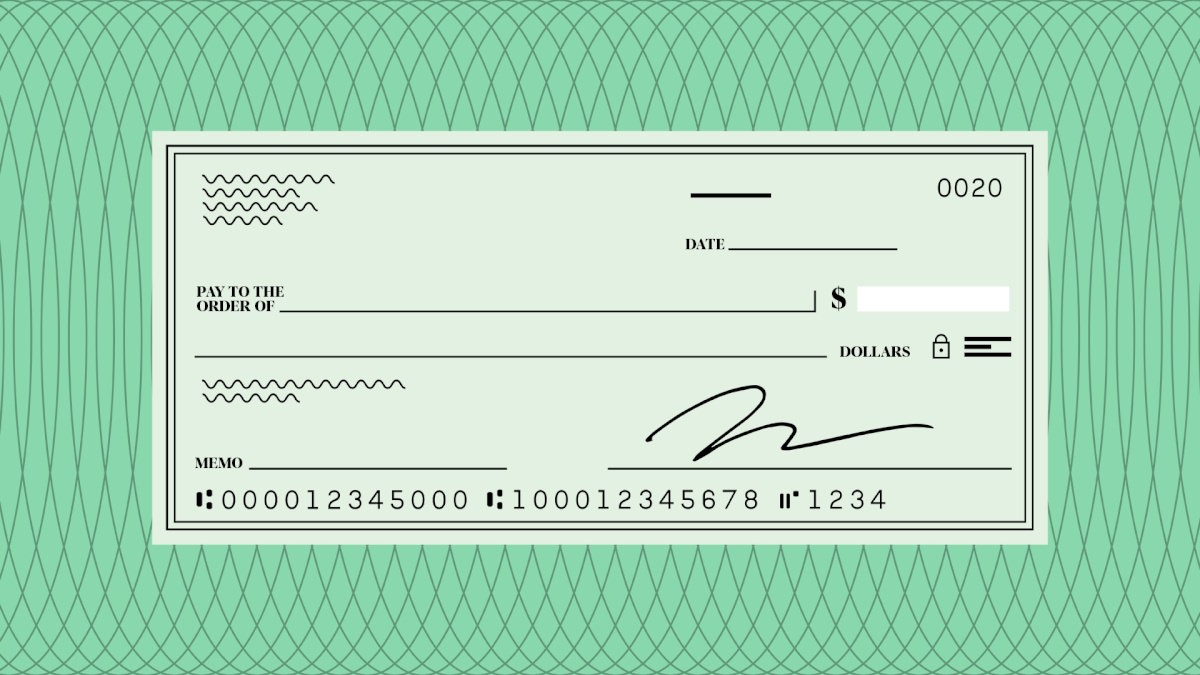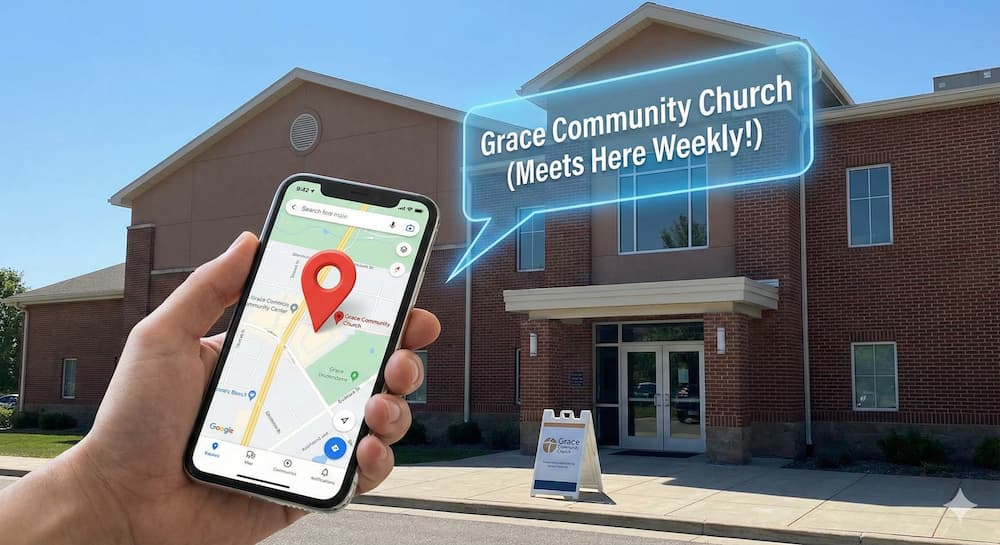How to Write a Check Explained in This Simple Step-by-Step Guide
Trying to figure out how to write a check? Don’t sweat it. You’re not alone. Here we break down the steps you need you to take.

There are countless ways you can pay or donate money these days—Apple Pay, text giving, Venmo, credit cards, debit cards, online, and cold, hard cash. Amidst all of this technology, we occasionally forget an age-old method—the personal check.
When I was in sixth grade, our math teacher did an entire month on personal finances. We had to write fake checks for fictional utilities and bills. We had to balance a theoretical checkbook. Even though I rarely use checks now, I still got good practice filling them out.
For that reason, I’m probably an anomaly by today’s standards. According to a study, about four in 10 Americans almost never use checks for anything.. And personal check usage is on a steady decline. Many people have forgotten how to write a check altogether. And at Tithe.ly, in their church giving statistics, they’ve seen a steady trend toward donating online and with mobile devices.
Which explains the need for blog posts like this one. Because whether your a church leader or just someone hoping to give to your local church, writing personal checks is still an appropriate skill.
Here, we’re going to breakdown the following:
- The anatomy of a check
- How to write a check
- When you should use a check
Let’s dig in!
The anatomy of a check

Most of us know a check when we see one—even if we rarely use them. However, do you know what each section of the check means? Here are some insights into the different parts of a check.
The numbers below correspond to the numbers listed on the fake check above:
1. Your name and address. This verifies who the check is from. Hopefully, that’s you.
2. Check number. Did you notice that each of the checks has a sequential number in the corner? This is based on how many checks you’ve written from this account. The same number also shows up at the bottom of the check after the routing and account numbers.
3. Date: This is where you write the date you wrote the check. Who would have guessed?
4. Pay to the order of. This is who the check is being made out to. Try to get this right.
5. Dollar amount. This includes a box where you write the check amount in digits and a line where you write out the same amount in text. Make sure they match up.
6. For/Memo. This is a way for you to signify what this check is being written for.
7. Signature line. You need to sign a check to verify that it had your approval to be deposited or cashed. This is an important step to keeping your money safe.
8. Routing number. The first set of digits along the bottom is your bank’s ABA number to let people know where the money will be coming from.
9. Account number. This second set of digits is your specific checking account number.
10. Endorsement line. If you flip over a check to the back, you’ll notice another line. This is where the person depositing the check will sign. This makes sure it is only deposited once.
How to write a check
For people over the age of 40, it might be insulting to assume they don’t know how to write a check. For people under the age of 20, it might be too much to assume they even know what a check is. Either way, there are still some best practices when it comes to writing a check:
- Include the date. Write out the date you’re writing the check. During 2020, be sure to write out the full ‘2020’ instead of appreciating the year to avoid check date fraud.
- Add the payee name. Who are you trying to pay? If you’re not sure, be sure to ask them, because it could impact if they’re able to deposit the money. If you’re not sure, you can write CASH in the line so they can get the amount out as cash. However, be aware because this means anyone with that physical check can take out the money.
- Write the amount in numbers. How much do you want to pay? Write down this number in the little box next to the payee name. Be sure to include the decimal point and two digits, even if there isn’t any change. Otherwise, someone could alter this number.
- Write the amount in words. Write out that same amount number in words along the second line. Why do you need to write it again? This is a safeguard in case someone tries to alter one number or the other. Include the amount of change in this line, too.
- Add a note. What is the payment for? Monthly tithe? Birthday gift? This section is optional, but it’s recommended. Keep in mind, this is more for your sake than the payee. Most banks will scan the deposited check and allow you to see it on your statement. So you won’t have to wonder what that $100 check was supposed to be for.
- Sign the check. Do you actually want to pay this amount? Go ahead and sign it! You’re supposed to use the same signature that you made when you opened the checking account. But most banks rarely check unless they suspect fraud.
When should I use a check for payment?
Despite the wide range of payment options available to us, there are still times when writing a check is your best option. You still need to make sure you’re doing so safely, but here are some situations when to rely on a personal check.
- For large payments. Trying to buy a car or paying your mortgage? Personal checks are more reliable for these large payments of several thousand dollars because the payee can be sure you have enough funds to cover the amount. Besides, credit cards can have limits, and most people don’t want to carry that much cash around.
- As a gift. There’s a reason why grandma always sends you a check for $15 on your birthday every year. Because it’s an easy way to transfer small amounts of money safely. And plus, she hasn’t figured out how to use Venmo yet.
- When credit cards aren’t accepted. Believe it or not, credit cards aren’t accepted everywhere. They charge a transaction fee and some small businesses don’t want to pay those. So they’re sometimes willing to accept personal checks.
- Tithing to your church. Donating to your local church via paper check is still a favorite for many people. This helps you trace your giving and makes it easy for your church to deposit. Online giving has its advantages, but there will always be a place for paper donations.
Obviously, these aren’t the only times you can use a personal check for payment. These are just some of the instances when they might be a better idea than a credit card or cash. It really depends on the situation and your personal preference.
Tips for using checks
Knowing when to use a check and where to put the right information gets you most of the way there. However, there are plenty of other tips you should keep in mind when using a check—especially if you’re not used to paying this way.
- Have enough money. Before writing a check, make sure that you have enough money in your checking account to comfortably cover the account. Having insufficient funds for a check is called bouncing a check, and it can lead to all sorts of credit problems.
- Write legibly. Our dependence on technology is not just killing personal checks, it’s also diminishing our handwriting. Take your time to make sure people can actually read what you’re writing. This will help you avoid some confusion later.
- Write only in pen. Don’t try to fill out a check in pencil. Banks usually won’t accept it because it’s to easy to erase and rewrite a new amount. Stick to permanent ink.
- Include the cents. When writing out the check amount, always include the numbers after the decimal, even if the amount has not cents. So write $151.00 instead of just $151. Or One Hundred and Fifty-One Dollars and 0/100. This prevents someone from slipping in an extra zero, which could cost you quite a bit of money.
- You don’t have to write in cursive. In school, I was told that we were required to fill out checks using cursive. Because that’s how all adults did it. But that’s just not true. I never fill out my checks in cursive and they always cash just fine.
- Don’t try to change anything. If you mess up writing something on the check, don’t try to cross it out. That could lead to confusion later. Just write VOID on the check (or shred it) and start over again on a new check.
Church leaders should look beyond checks
For church leaders, tithes via personal checks may be a good source of income, but are an unreliable method of securing financial stability as a church when compared to digital church giving. At Tithe.ly, in our analysis of the 25,000+ churches that use our service, we have seen that churches who lean heavily on digital recurring giving methods (such as Tithe.ly Giving) produce a 165% increase in giving year-over-year.
The best way to achieve financial stability for your church in the 21st century is to follow these steps:
- Adopt an easy-to-use digital giving option. Using a digital giving option isn't helpful if your technology is not easy to use. For example, with Tithe.ly Giving, your church members can give to your church right on your church website, app, or even via SMS with a single button.
- Teach your congregants how to give digitally. Spend one of your Sundays in church teaching your congregation how to use the giving technology so that you know everyone has been trained. It may even be appropriate to preach on giving that Sunday and include a basic walkthrough in your sermon.
- Make compelling calls to give that integrates your digital giving technology. The best church technology tools in the world won't help you grow your giving if you don't ask people to give. Our data shows that pastors who preach on giving regularly receive more donations by a large factor. The better you ask, and the more you ask, and the easier it is to give, the more people will give.
It's important to know how to collect checks as a means of giving. But increasingly, it is important for churches to encourage their congregations to give digitally so that their own finances can be more stable, congregants are not forced to opt in to giving every Sunday, and the ease-of-use barrier to giving is almost erased by the technology that you use. If you implement these strategies, you'll find that the time cost of check writing and processing is a beautiful way that people used to give, but won't be sustainable as time, business wisdom, and technological progress marches on.
Sign Up for Product Updates
There are countless ways you can pay or donate money these days—Apple Pay, text giving, Venmo, credit cards, debit cards, online, and cold, hard cash. Amidst all of this technology, we occasionally forget an age-old method—the personal check.
When I was in sixth grade, our math teacher did an entire month on personal finances. We had to write fake checks for fictional utilities and bills. We had to balance a theoretical checkbook. Even though I rarely use checks now, I still got good practice filling them out.
For that reason, I’m probably an anomaly by today’s standards. According to a study, about four in 10 Americans almost never use checks for anything.. And personal check usage is on a steady decline. Many people have forgotten how to write a check altogether. And at Tithe.ly, in their church giving statistics, they’ve seen a steady trend toward donating online and with mobile devices.
Which explains the need for blog posts like this one. Because whether your a church leader or just someone hoping to give to your local church, writing personal checks is still an appropriate skill.
Here, we’re going to breakdown the following:
- The anatomy of a check
- How to write a check
- When you should use a check
Let’s dig in!
The anatomy of a check

Most of us know a check when we see one—even if we rarely use them. However, do you know what each section of the check means? Here are some insights into the different parts of a check.
The numbers below correspond to the numbers listed on the fake check above:
1. Your name and address. This verifies who the check is from. Hopefully, that’s you.
2. Check number. Did you notice that each of the checks has a sequential number in the corner? This is based on how many checks you’ve written from this account. The same number also shows up at the bottom of the check after the routing and account numbers.
3. Date: This is where you write the date you wrote the check. Who would have guessed?
4. Pay to the order of. This is who the check is being made out to. Try to get this right.
5. Dollar amount. This includes a box where you write the check amount in digits and a line where you write out the same amount in text. Make sure they match up.
6. For/Memo. This is a way for you to signify what this check is being written for.
7. Signature line. You need to sign a check to verify that it had your approval to be deposited or cashed. This is an important step to keeping your money safe.
8. Routing number. The first set of digits along the bottom is your bank’s ABA number to let people know where the money will be coming from.
9. Account number. This second set of digits is your specific checking account number.
10. Endorsement line. If you flip over a check to the back, you’ll notice another line. This is where the person depositing the check will sign. This makes sure it is only deposited once.
How to write a check
For people over the age of 40, it might be insulting to assume they don’t know how to write a check. For people under the age of 20, it might be too much to assume they even know what a check is. Either way, there are still some best practices when it comes to writing a check:
- Include the date. Write out the date you’re writing the check. During 2020, be sure to write out the full ‘2020’ instead of appreciating the year to avoid check date fraud.
- Add the payee name. Who are you trying to pay? If you’re not sure, be sure to ask them, because it could impact if they’re able to deposit the money. If you’re not sure, you can write CASH in the line so they can get the amount out as cash. However, be aware because this means anyone with that physical check can take out the money.
- Write the amount in numbers. How much do you want to pay? Write down this number in the little box next to the payee name. Be sure to include the decimal point and two digits, even if there isn’t any change. Otherwise, someone could alter this number.
- Write the amount in words. Write out that same amount number in words along the second line. Why do you need to write it again? This is a safeguard in case someone tries to alter one number or the other. Include the amount of change in this line, too.
- Add a note. What is the payment for? Monthly tithe? Birthday gift? This section is optional, but it’s recommended. Keep in mind, this is more for your sake than the payee. Most banks will scan the deposited check and allow you to see it on your statement. So you won’t have to wonder what that $100 check was supposed to be for.
- Sign the check. Do you actually want to pay this amount? Go ahead and sign it! You’re supposed to use the same signature that you made when you opened the checking account. But most banks rarely check unless they suspect fraud.
When should I use a check for payment?
Despite the wide range of payment options available to us, there are still times when writing a check is your best option. You still need to make sure you’re doing so safely, but here are some situations when to rely on a personal check.
- For large payments. Trying to buy a car or paying your mortgage? Personal checks are more reliable for these large payments of several thousand dollars because the payee can be sure you have enough funds to cover the amount. Besides, credit cards can have limits, and most people don’t want to carry that much cash around.
- As a gift. There’s a reason why grandma always sends you a check for $15 on your birthday every year. Because it’s an easy way to transfer small amounts of money safely. And plus, she hasn’t figured out how to use Venmo yet.
- When credit cards aren’t accepted. Believe it or not, credit cards aren’t accepted everywhere. They charge a transaction fee and some small businesses don’t want to pay those. So they’re sometimes willing to accept personal checks.
- Tithing to your church. Donating to your local church via paper check is still a favorite for many people. This helps you trace your giving and makes it easy for your church to deposit. Online giving has its advantages, but there will always be a place for paper donations.
Obviously, these aren’t the only times you can use a personal check for payment. These are just some of the instances when they might be a better idea than a credit card or cash. It really depends on the situation and your personal preference.
Tips for using checks
Knowing when to use a check and where to put the right information gets you most of the way there. However, there are plenty of other tips you should keep in mind when using a check—especially if you’re not used to paying this way.
- Have enough money. Before writing a check, make sure that you have enough money in your checking account to comfortably cover the account. Having insufficient funds for a check is called bouncing a check, and it can lead to all sorts of credit problems.
- Write legibly. Our dependence on technology is not just killing personal checks, it’s also diminishing our handwriting. Take your time to make sure people can actually read what you’re writing. This will help you avoid some confusion later.
- Write only in pen. Don’t try to fill out a check in pencil. Banks usually won’t accept it because it’s to easy to erase and rewrite a new amount. Stick to permanent ink.
- Include the cents. When writing out the check amount, always include the numbers after the decimal, even if the amount has not cents. So write $151.00 instead of just $151. Or One Hundred and Fifty-One Dollars and 0/100. This prevents someone from slipping in an extra zero, which could cost you quite a bit of money.
- You don’t have to write in cursive. In school, I was told that we were required to fill out checks using cursive. Because that’s how all adults did it. But that’s just not true. I never fill out my checks in cursive and they always cash just fine.
- Don’t try to change anything. If you mess up writing something on the check, don’t try to cross it out. That could lead to confusion later. Just write VOID on the check (or shred it) and start over again on a new check.
Church leaders should look beyond checks
For church leaders, tithes via personal checks may be a good source of income, but are an unreliable method of securing financial stability as a church when compared to digital church giving. At Tithe.ly, in our analysis of the 25,000+ churches that use our service, we have seen that churches who lean heavily on digital recurring giving methods (such as Tithe.ly Giving) produce a 165% increase in giving year-over-year.
The best way to achieve financial stability for your church in the 21st century is to follow these steps:
- Adopt an easy-to-use digital giving option. Using a digital giving option isn't helpful if your technology is not easy to use. For example, with Tithe.ly Giving, your church members can give to your church right on your church website, app, or even via SMS with a single button.
- Teach your congregants how to give digitally. Spend one of your Sundays in church teaching your congregation how to use the giving technology so that you know everyone has been trained. It may even be appropriate to preach on giving that Sunday and include a basic walkthrough in your sermon.
- Make compelling calls to give that integrates your digital giving technology. The best church technology tools in the world won't help you grow your giving if you don't ask people to give. Our data shows that pastors who preach on giving regularly receive more donations by a large factor. The better you ask, and the more you ask, and the easier it is to give, the more people will give.
It's important to know how to collect checks as a means of giving. But increasingly, it is important for churches to encourage their congregations to give digitally so that their own finances can be more stable, congregants are not forced to opt in to giving every Sunday, and the ease-of-use barrier to giving is almost erased by the technology that you use. If you implement these strategies, you'll find that the time cost of check writing and processing is a beautiful way that people used to give, but won't be sustainable as time, business wisdom, and technological progress marches on.
podcast transcript
There are countless ways you can pay or donate money these days—Apple Pay, text giving, Venmo, credit cards, debit cards, online, and cold, hard cash. Amidst all of this technology, we occasionally forget an age-old method—the personal check.
When I was in sixth grade, our math teacher did an entire month on personal finances. We had to write fake checks for fictional utilities and bills. We had to balance a theoretical checkbook. Even though I rarely use checks now, I still got good practice filling them out.
For that reason, I’m probably an anomaly by today’s standards. According to a study, about four in 10 Americans almost never use checks for anything.. And personal check usage is on a steady decline. Many people have forgotten how to write a check altogether. And at Tithe.ly, in their church giving statistics, they’ve seen a steady trend toward donating online and with mobile devices.
Which explains the need for blog posts like this one. Because whether your a church leader or just someone hoping to give to your local church, writing personal checks is still an appropriate skill.
Here, we’re going to breakdown the following:
- The anatomy of a check
- How to write a check
- When you should use a check
Let’s dig in!
The anatomy of a check

Most of us know a check when we see one—even if we rarely use them. However, do you know what each section of the check means? Here are some insights into the different parts of a check.
The numbers below correspond to the numbers listed on the fake check above:
1. Your name and address. This verifies who the check is from. Hopefully, that’s you.
2. Check number. Did you notice that each of the checks has a sequential number in the corner? This is based on how many checks you’ve written from this account. The same number also shows up at the bottom of the check after the routing and account numbers.
3. Date: This is where you write the date you wrote the check. Who would have guessed?
4. Pay to the order of. This is who the check is being made out to. Try to get this right.
5. Dollar amount. This includes a box where you write the check amount in digits and a line where you write out the same amount in text. Make sure they match up.
6. For/Memo. This is a way for you to signify what this check is being written for.
7. Signature line. You need to sign a check to verify that it had your approval to be deposited or cashed. This is an important step to keeping your money safe.
8. Routing number. The first set of digits along the bottom is your bank’s ABA number to let people know where the money will be coming from.
9. Account number. This second set of digits is your specific checking account number.
10. Endorsement line. If you flip over a check to the back, you’ll notice another line. This is where the person depositing the check will sign. This makes sure it is only deposited once.
How to write a check
For people over the age of 40, it might be insulting to assume they don’t know how to write a check. For people under the age of 20, it might be too much to assume they even know what a check is. Either way, there are still some best practices when it comes to writing a check:
- Include the date. Write out the date you’re writing the check. During 2020, be sure to write out the full ‘2020’ instead of appreciating the year to avoid check date fraud.
- Add the payee name. Who are you trying to pay? If you’re not sure, be sure to ask them, because it could impact if they’re able to deposit the money. If you’re not sure, you can write CASH in the line so they can get the amount out as cash. However, be aware because this means anyone with that physical check can take out the money.
- Write the amount in numbers. How much do you want to pay? Write down this number in the little box next to the payee name. Be sure to include the decimal point and two digits, even if there isn’t any change. Otherwise, someone could alter this number.
- Write the amount in words. Write out that same amount number in words along the second line. Why do you need to write it again? This is a safeguard in case someone tries to alter one number or the other. Include the amount of change in this line, too.
- Add a note. What is the payment for? Monthly tithe? Birthday gift? This section is optional, but it’s recommended. Keep in mind, this is more for your sake than the payee. Most banks will scan the deposited check and allow you to see it on your statement. So you won’t have to wonder what that $100 check was supposed to be for.
- Sign the check. Do you actually want to pay this amount? Go ahead and sign it! You’re supposed to use the same signature that you made when you opened the checking account. But most banks rarely check unless they suspect fraud.
When should I use a check for payment?
Despite the wide range of payment options available to us, there are still times when writing a check is your best option. You still need to make sure you’re doing so safely, but here are some situations when to rely on a personal check.
- For large payments. Trying to buy a car or paying your mortgage? Personal checks are more reliable for these large payments of several thousand dollars because the payee can be sure you have enough funds to cover the amount. Besides, credit cards can have limits, and most people don’t want to carry that much cash around.
- As a gift. There’s a reason why grandma always sends you a check for $15 on your birthday every year. Because it’s an easy way to transfer small amounts of money safely. And plus, she hasn’t figured out how to use Venmo yet.
- When credit cards aren’t accepted. Believe it or not, credit cards aren’t accepted everywhere. They charge a transaction fee and some small businesses don’t want to pay those. So they’re sometimes willing to accept personal checks.
- Tithing to your church. Donating to your local church via paper check is still a favorite for many people. This helps you trace your giving and makes it easy for your church to deposit. Online giving has its advantages, but there will always be a place for paper donations.
Obviously, these aren’t the only times you can use a personal check for payment. These are just some of the instances when they might be a better idea than a credit card or cash. It really depends on the situation and your personal preference.
Tips for using checks
Knowing when to use a check and where to put the right information gets you most of the way there. However, there are plenty of other tips you should keep in mind when using a check—especially if you’re not used to paying this way.
- Have enough money. Before writing a check, make sure that you have enough money in your checking account to comfortably cover the account. Having insufficient funds for a check is called bouncing a check, and it can lead to all sorts of credit problems.
- Write legibly. Our dependence on technology is not just killing personal checks, it’s also diminishing our handwriting. Take your time to make sure people can actually read what you’re writing. This will help you avoid some confusion later.
- Write only in pen. Don’t try to fill out a check in pencil. Banks usually won’t accept it because it’s to easy to erase and rewrite a new amount. Stick to permanent ink.
- Include the cents. When writing out the check amount, always include the numbers after the decimal, even if the amount has not cents. So write $151.00 instead of just $151. Or One Hundred and Fifty-One Dollars and 0/100. This prevents someone from slipping in an extra zero, which could cost you quite a bit of money.
- You don’t have to write in cursive. In school, I was told that we were required to fill out checks using cursive. Because that’s how all adults did it. But that’s just not true. I never fill out my checks in cursive and they always cash just fine.
- Don’t try to change anything. If you mess up writing something on the check, don’t try to cross it out. That could lead to confusion later. Just write VOID on the check (or shred it) and start over again on a new check.
Church leaders should look beyond checks
For church leaders, tithes via personal checks may be a good source of income, but are an unreliable method of securing financial stability as a church when compared to digital church giving. At Tithe.ly, in our analysis of the 25,000+ churches that use our service, we have seen that churches who lean heavily on digital recurring giving methods (such as Tithe.ly Giving) produce a 165% increase in giving year-over-year.
The best way to achieve financial stability for your church in the 21st century is to follow these steps:
- Adopt an easy-to-use digital giving option. Using a digital giving option isn't helpful if your technology is not easy to use. For example, with Tithe.ly Giving, your church members can give to your church right on your church website, app, or even via SMS with a single button.
- Teach your congregants how to give digitally. Spend one of your Sundays in church teaching your congregation how to use the giving technology so that you know everyone has been trained. It may even be appropriate to preach on giving that Sunday and include a basic walkthrough in your sermon.
- Make compelling calls to give that integrates your digital giving technology. The best church technology tools in the world won't help you grow your giving if you don't ask people to give. Our data shows that pastors who preach on giving regularly receive more donations by a large factor. The better you ask, and the more you ask, and the easier it is to give, the more people will give.
It's important to know how to collect checks as a means of giving. But increasingly, it is important for churches to encourage their congregations to give digitally so that their own finances can be more stable, congregants are not forced to opt in to giving every Sunday, and the ease-of-use barrier to giving is almost erased by the technology that you use. If you implement these strategies, you'll find that the time cost of check writing and processing is a beautiful way that people used to give, but won't be sustainable as time, business wisdom, and technological progress marches on.
VIDEO transcript
There are countless ways you can pay or donate money these days—Apple Pay, text giving, Venmo, credit cards, debit cards, online, and cold, hard cash. Amidst all of this technology, we occasionally forget an age-old method—the personal check.
When I was in sixth grade, our math teacher did an entire month on personal finances. We had to write fake checks for fictional utilities and bills. We had to balance a theoretical checkbook. Even though I rarely use checks now, I still got good practice filling them out.
For that reason, I’m probably an anomaly by today’s standards. According to a study, about four in 10 Americans almost never use checks for anything.. And personal check usage is on a steady decline. Many people have forgotten how to write a check altogether. And at Tithe.ly, in their church giving statistics, they’ve seen a steady trend toward donating online and with mobile devices.
Which explains the need for blog posts like this one. Because whether your a church leader or just someone hoping to give to your local church, writing personal checks is still an appropriate skill.
Here, we’re going to breakdown the following:
- The anatomy of a check
- How to write a check
- When you should use a check
Let’s dig in!
The anatomy of a check

Most of us know a check when we see one—even if we rarely use them. However, do you know what each section of the check means? Here are some insights into the different parts of a check.
The numbers below correspond to the numbers listed on the fake check above:
1. Your name and address. This verifies who the check is from. Hopefully, that’s you.
2. Check number. Did you notice that each of the checks has a sequential number in the corner? This is based on how many checks you’ve written from this account. The same number also shows up at the bottom of the check after the routing and account numbers.
3. Date: This is where you write the date you wrote the check. Who would have guessed?
4. Pay to the order of. This is who the check is being made out to. Try to get this right.
5. Dollar amount. This includes a box where you write the check amount in digits and a line where you write out the same amount in text. Make sure they match up.
6. For/Memo. This is a way for you to signify what this check is being written for.
7. Signature line. You need to sign a check to verify that it had your approval to be deposited or cashed. This is an important step to keeping your money safe.
8. Routing number. The first set of digits along the bottom is your bank’s ABA number to let people know where the money will be coming from.
9. Account number. This second set of digits is your specific checking account number.
10. Endorsement line. If you flip over a check to the back, you’ll notice another line. This is where the person depositing the check will sign. This makes sure it is only deposited once.
How to write a check
For people over the age of 40, it might be insulting to assume they don’t know how to write a check. For people under the age of 20, it might be too much to assume they even know what a check is. Either way, there are still some best practices when it comes to writing a check:
- Include the date. Write out the date you’re writing the check. During 2020, be sure to write out the full ‘2020’ instead of appreciating the year to avoid check date fraud.
- Add the payee name. Who are you trying to pay? If you’re not sure, be sure to ask them, because it could impact if they’re able to deposit the money. If you’re not sure, you can write CASH in the line so they can get the amount out as cash. However, be aware because this means anyone with that physical check can take out the money.
- Write the amount in numbers. How much do you want to pay? Write down this number in the little box next to the payee name. Be sure to include the decimal point and two digits, even if there isn’t any change. Otherwise, someone could alter this number.
- Write the amount in words. Write out that same amount number in words along the second line. Why do you need to write it again? This is a safeguard in case someone tries to alter one number or the other. Include the amount of change in this line, too.
- Add a note. What is the payment for? Monthly tithe? Birthday gift? This section is optional, but it’s recommended. Keep in mind, this is more for your sake than the payee. Most banks will scan the deposited check and allow you to see it on your statement. So you won’t have to wonder what that $100 check was supposed to be for.
- Sign the check. Do you actually want to pay this amount? Go ahead and sign it! You’re supposed to use the same signature that you made when you opened the checking account. But most banks rarely check unless they suspect fraud.
When should I use a check for payment?
Despite the wide range of payment options available to us, there are still times when writing a check is your best option. You still need to make sure you’re doing so safely, but here are some situations when to rely on a personal check.
- For large payments. Trying to buy a car or paying your mortgage? Personal checks are more reliable for these large payments of several thousand dollars because the payee can be sure you have enough funds to cover the amount. Besides, credit cards can have limits, and most people don’t want to carry that much cash around.
- As a gift. There’s a reason why grandma always sends you a check for $15 on your birthday every year. Because it’s an easy way to transfer small amounts of money safely. And plus, she hasn’t figured out how to use Venmo yet.
- When credit cards aren’t accepted. Believe it or not, credit cards aren’t accepted everywhere. They charge a transaction fee and some small businesses don’t want to pay those. So they’re sometimes willing to accept personal checks.
- Tithing to your church. Donating to your local church via paper check is still a favorite for many people. This helps you trace your giving and makes it easy for your church to deposit. Online giving has its advantages, but there will always be a place for paper donations.
Obviously, these aren’t the only times you can use a personal check for payment. These are just some of the instances when they might be a better idea than a credit card or cash. It really depends on the situation and your personal preference.
Tips for using checks
Knowing when to use a check and where to put the right information gets you most of the way there. However, there are plenty of other tips you should keep in mind when using a check—especially if you’re not used to paying this way.
- Have enough money. Before writing a check, make sure that you have enough money in your checking account to comfortably cover the account. Having insufficient funds for a check is called bouncing a check, and it can lead to all sorts of credit problems.
- Write legibly. Our dependence on technology is not just killing personal checks, it’s also diminishing our handwriting. Take your time to make sure people can actually read what you’re writing. This will help you avoid some confusion later.
- Write only in pen. Don’t try to fill out a check in pencil. Banks usually won’t accept it because it’s to easy to erase and rewrite a new amount. Stick to permanent ink.
- Include the cents. When writing out the check amount, always include the numbers after the decimal, even if the amount has not cents. So write $151.00 instead of just $151. Or One Hundred and Fifty-One Dollars and 0/100. This prevents someone from slipping in an extra zero, which could cost you quite a bit of money.
- You don’t have to write in cursive. In school, I was told that we were required to fill out checks using cursive. Because that’s how all adults did it. But that’s just not true. I never fill out my checks in cursive and they always cash just fine.
- Don’t try to change anything. If you mess up writing something on the check, don’t try to cross it out. That could lead to confusion later. Just write VOID on the check (or shred it) and start over again on a new check.
Church leaders should look beyond checks
For church leaders, tithes via personal checks may be a good source of income, but are an unreliable method of securing financial stability as a church when compared to digital church giving. At Tithe.ly, in our analysis of the 25,000+ churches that use our service, we have seen that churches who lean heavily on digital recurring giving methods (such as Tithe.ly Giving) produce a 165% increase in giving year-over-year.
The best way to achieve financial stability for your church in the 21st century is to follow these steps:
- Adopt an easy-to-use digital giving option. Using a digital giving option isn't helpful if your technology is not easy to use. For example, with Tithe.ly Giving, your church members can give to your church right on your church website, app, or even via SMS with a single button.
- Teach your congregants how to give digitally. Spend one of your Sundays in church teaching your congregation how to use the giving technology so that you know everyone has been trained. It may even be appropriate to preach on giving that Sunday and include a basic walkthrough in your sermon.
- Make compelling calls to give that integrates your digital giving technology. The best church technology tools in the world won't help you grow your giving if you don't ask people to give. Our data shows that pastors who preach on giving regularly receive more donations by a large factor. The better you ask, and the more you ask, and the easier it is to give, the more people will give.
It's important to know how to collect checks as a means of giving. But increasingly, it is important for churches to encourage their congregations to give digitally so that their own finances can be more stable, congregants are not forced to opt in to giving every Sunday, and the ease-of-use barrier to giving is almost erased by the technology that you use. If you implement these strategies, you'll find that the time cost of check writing and processing is a beautiful way that people used to give, but won't be sustainable as time, business wisdom, and technological progress marches on.


















.jpg)









